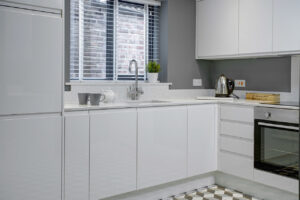Condensation and damp can cause serious problems for a home. It’s not just the fact it looks and smells unsightly, it can be damaging to your health too.
Dougie from our in-house property maintenance team have put together a guide for how to manage the moisture that is generated in every home.
He said:
“Now we are in the winter months you may notice issues with condensation and mould in your rented property. This is usually because during this colder time, we start to feel the cold more and spend more time inside our homes, resulting in greater humidity and a build-up of moisture. Condensation can quickly turn into damp and mould if not swiftly dealt with”.
FACT – From just one load of washing, two litres of water is emitted into the air
What are the signs of condensation, damp and mould?
If your property is suffering from condensation and damp, you may notice the following indicators:
. Wallpaper starts to peel
. Damp patches appear on walls
. A build-up of moisture on your windows
. Musty, damp smell
. Water runs down walls and windows
. Mould growth, most commonly on exterior walls
. Staining on walls
FACT – Four people living in a three bedroom property would create 1.5 pints of moisture a week from just breathing, cooking, showering and boiling the kettle
What can I do to prevent condensation, damp and mould?
There are several preventative measures you can take to help inhibit any condensation issues from appearing within your home:
. Ensure that any washing machines or tumble dryers are correctly vented.
. If possible, dry clothes outdoors to prevent excess moisture escaping into your property. If this is not possible,
open doors or windows.
. When taking a shower or cooking, ensure that your kitchen or bathroom doors are closed to avoid excess
moisture escaping into other rooms.
. Cover your pans when cooking to avoid the steam escaping where possible.
. Use an extractor fan if you have one, when cooking or showering, or open a window for at least 15-20 minutes.
. Wipe down and dry surfaces after you are finished using them in the kitchen or bathroom, as excess moisture
can quickly turn to mould.
. Do not overfill wardrobes or cupboards. Overfilled spaces such as these are breeding grounds for mould as the
air cannot easily circulate.
. Keep furniture at least 50mm away from surrounding walls so that air can easily move around your property.
. Ensure that the property is adequately heated.
. Open the windows slightly in any rooms you regularly use.
What can I do to tackle condensation, damp and mould?
If your home has condensation-related issues, it is imperative to get these sorted as soon as you notice the signs.
There are three ways you can tackle the problem
. wipe down affected walls and window frames with a fungicidal wash
. dry clean or machine wash mildewed clothes
. shampoo mouldy carpets.
REMEMBER: THERE ARE THREE THINGS THAT CAUSE CONDENSATON:
1: TOO MUCH MOISTURE
2: NOT ENOUGH VENTILATION
3: NOT ENOUGH HEATING
What can I do if the problem is more severe?
If the problem is more severe, you should contact us in the James Peacock Property Office as soon as possible so that we can notify the landlord and consider any longer-term action that may be required. Call the office on 01925 243366 or email info@jamespeacockproperty.co.uk















